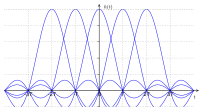
Photo from wikipedia
We propose in this letter the oversampling based combining scheme under inter-symbol interference (ISI) channels, where the receiver samples the received signal at the rate that is higher than the… Click to show full abstract
We propose in this letter the oversampling based combining scheme under inter-symbol interference (ISI) channels, where the receiver samples the received signal at the rate that is higher than the symbol rate and performs combining over the channel length for each transmitted symbol. We show that by increasing the sampling rate, the achievable rate of the proposed scheme approaches the achievable rate of the ISI-free scheme in multi-path channels. Furthermore, we prove that if the sufficient condition is satisfied, then increasing the sampling rate makes the proposed scheme eliminate the effect of ISI so that the signal to interference-plus-noise ratio (SINR) for the output of the combiner approaches the SNR for AWGN channel (without fading and without ISI). This result leads to the facts that the error probability of the proposed scheme can approach that of AWGN channel and the achievable rate of the proposed scheme can approach the channel capacity of AWGN channel. The proposed scheme is a linear scheme and the achievable rate of the proposed scheme can be close to the channel capacity of AWGN channel with small increase in the computational complexity.
Journal Title: IEEE Wireless Communications Letters
Year Published: 2023
Link to full text (if available)
Share on Social Media: Sign Up to like & get
recommendations!